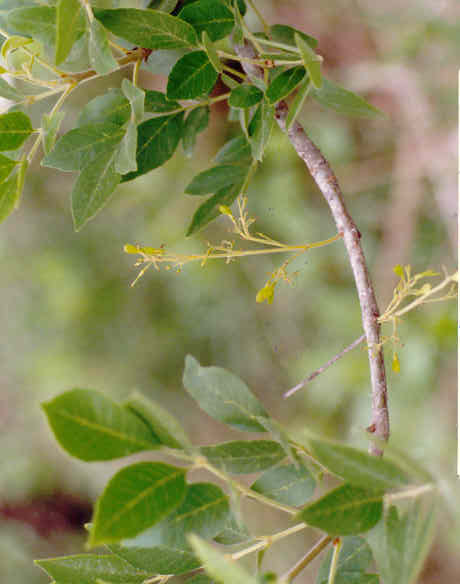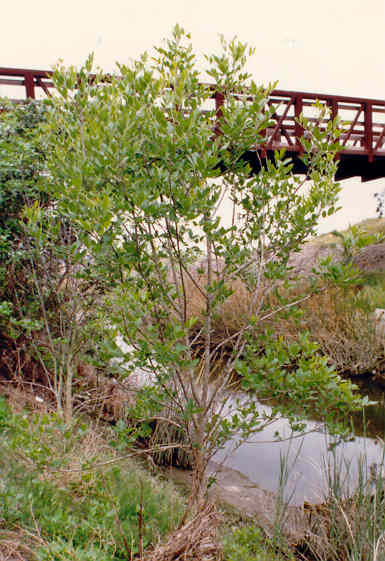
Fraxinus velutina Torr.
=Fraxinus velutina var. coriacea
 |
Fraxinus velutina Torr.=Fraxinus velutina var. coriacea
Oleaceae (Olive Family)NativeVelvet AshChaparral Flowering AshLeather-Leaved Arizona Ash |
April Photo
Plant Characteristics:
Tree 5-10 m. tall; branchlets terete, +/-puberulent; lvs. opposite; lfts. 3-7,
lanceolate to ovate or obovate, 2-8 cm. long, thickish, subglabrous, strongly
veined, the lateral commonly on petiolules 3-10 mm. long;
plant dioecious; fls. before the lvs.; calyx ca. 1.5 mm. long; petals 0;
samaras 1-seeded, subterete, 1.5-2.5 (-3.5) cm. long, 4-7 mm. wide, the narrow
wing usually decurrent barely to the middle of the body.
Habitat:
Canyons and along streams, below 5000 ft.; deserts from Inyo Co. s.; to
Nev., Ariz., L. Calif. (Munz, Flora So. Calif. 588). Also
an escape from cultivation. (my
comment).
Name:
Fraxinus, Latin name of the
ash. (Munz, Flora So. Calif. 588).
Velutinus, velvety.
(Bailey 23). L. corium,
leather, skin, peeled. (Jaeger 66).
Coriaceous, leathery skin, possibly referring to the leaves.
(my comment).
General:
Rare in the study area. Found
only in the Delhi ditch above the new bike and horse bridge.
Of the two small trees photographed in May 1990, neither survived through
1991. One was infested with aphis
at the time of the photographs. The
small samaras I collected are +/- .9 cm. long.
Dave Bramblet suggested that they might have all been aborted.
(my comments).
The bark of F. excelsior, the European Ash, has been used as a diuretic and as a
febrifuge (a medicine effacious in reducing fever). Juice from the stems of F.
ornus is used as a laxative. (Meyer
16, 79). F. americana is useful
in dropsy, urinary troubles and constipation.
Excellent for reducing. This
is one of the old-fashioned, well-known remedies. (Kloss 193).
About 65 species of deciduous trees mostly native in the north temp.
zone, valuable as street and park trees. (Bailey
799). Apparently hybridizes with and
difficult to separate from F. latifolia
in southern Sierra Nevada and western Mojave Desert.
(Hickman, Ed. 776).
Variety coriacea not
recognized. (Hickman, Ed. 1344).
For additional data on Fraxinus sp.
see Fraxinus uhdei..
Text Ref:
Bailey 799; Hickman, Ed. 776; Munz, Flora
So. Calif. 588.
Photo Ref:
Mar-May 90 # 12,13,14
Identity: by John Johnson.
Computer Ref: Plant Data 424.
Have plant specimen.
Last edit 3/15/03.
 |
April Photo